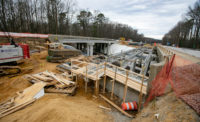Commentary: States Confront the Upcoming Cliff in Highway Finance
The federal legislation that currently funnels federal aid for highway and bridge construction to the states is entitled “Moving Ahead for Progress in the 21st Century” (or “MAP-21”). This legislation was passed as a two-year bill designed to authorize spending for FY 2013 and FY 2014. The legislation was due to expire October 31, 2014, but was extended last summer through May 31 of this year. The extension continued federal aid for highway, highway safety and public transportation programs at status quo funding levels.
Not only did Congress need to deal with the expiration of this authorizing legislation last year, it had to deal with a shortfall of funds in the Federal Highway Trust Fund, which provides the federal part of funding for highway and bridge projects. The Federal Highway Trust Fund is financed by the federal gasoline tax, which has funded highway and bridge construction since the 1930s. At 18.4 cents per gallon, the tax has not been increased since 1993.
Given the increased costs of construction, combined with improvements in auto fuel efficiency and modest cutbacks in the number of miles driven in the U.S., the gas tax no longer provides enough funding for highway and bridge construction projects. The federal government typically funds about $50 billion annually in transportation projects, while the gas tax currently brings in roughly $34 billion, a difference of about $16 billion.
As part of last year’s MAP-21 extension, Congress did a temporary fix for the Highway Trust Fund as well. Instead of providing a long-term solution to the shortfall, however, it simply transferred $7.77 billion for highways and bridges from the U.S. Treasury into the Federal Highway Trust Fund.
Unfortunately, Congress’ short-term solutions have only increased state anxieties about whether the federal government will be able to meet its responsibilities.
Uncertainty is the nemesis of large capital investment decisions, such as the decision to build or rebuild multi-million dollar streets and bridges. And because federal grants typically provide 80% of construction costs for major highway and bridge projects, the short timeline for the extension of the authorizing legislation and the continued questionable solvency of the Federal HighwayTrust Fund have caused state departments of transportation to be understandably reluctant to start new projects.
After last year’s extension, for example, Tennessee quickly reduced its highway and bridge program for FY 2015. This year, four other states have put $780 million of projects on hold and nine have said that $1.8 billion in projects are in jeopardy if Congress does not act on a multiyear transportation bill.
Unlikely Passage
With the expiration of the extension now at hand, it is once again unlikely that Congress will pass final reauthorizing legislation or provide a permanent fix for the trust fund. Insufficient progress has been made on decisions about the new surface transportation bill and particularly about how to fund future projects.
Congress, therefore, is likely to pass another continuation of the existing program at current levels of federal-aid spending. It’s assumed that another short-term transfer of funds will fill the gap in revenue until a longer-term solution can be found.
Of course, a new surface transportation bill will eventually be passed and the shortfall in the Highway Trust Fund will be dealt with—one way or another. The solution to the trust fund issue has been complicated by the fact that Congressional Republicans have said that an increase in the gas tax is “dead on arrival” because of their pledge to conservatives that no new taxes will be passed. Ironically, a recent poll conducted by California’s Mineta Transportation Institute found that 71% of voters would support a 10-cent increase in the federal gas tax if the money were spent on projects that maintain streets and bridges.
The Republican position on the gas tax means that, in all likelihood, the next surface transportation bill and the solution to the trust fund will shift more of the financial burden to the states. In fact, a number of states have already begun taking steps to increase their role by raising state gasoline excise taxes, increasing registration fees, instituting wholesale gasoline taxes, selling bonds to fill gaps or increasing involvement in public-private partnerships (PPPs).
For example, Texas voters approved last November’s Proposition 1, which earmarked roughly one-half of state oil and gas revenues (about $1.7 billion) for road and bridge construction. That measure, however, provided only a partial solution to the state’s funding gap, which, according to the chairman of the Texas transportation committee, is $4 to $5 billion annually.
Another example of state leadership is Ohio, which just launched a $2.4-billion capital plan for 2015 that will be the second largest in the state’s history and the first to feature a public-private partnership.
Similarly, Illinois recently passed a $12-billion, 15-year program aimed at upgrading existing facilities and building new toll roads. Minnesota has also joined the ranks of states proposing a new gasoline tax. That proposal would raise the state’s gas tax by 16 cents on top of the 28.5-cent tax the state’s drivers already pay.
New Jersey Gov. Chris Christie is facing increasing pressure to reform how the state funds transportation infrastructure, as debt service increases to roughly $1.2 billion in 2015. And finally, Pennsylvania just passed the Rapid Bridge Replacement Project, the state’s first public-private partnership that, in a single contract, will replace 558 structurally deficient bridges over the next three years. In February, the state raised $800 million through the sale of private activity bonds.
Uncertainty about the future of federal aid is likely to last into early next year. That will mean restrained increases in construction starts for both 2015 and 2016. After next year, however, new legislation will combine with improved state finances and innovative approaches to funding surface transportation projects to help lift construction starts more vigorously.
Dodge Data & Analytics is the parent company of ENR.



